The global flexible packaging market is estimated to be valued at USD 298.11 Bn in 2024 and is expected to reach USD 426.74 Bn by 2031, growing at a compound annual growth rate (CAGR) of 5.3% from 2024 to 2031.
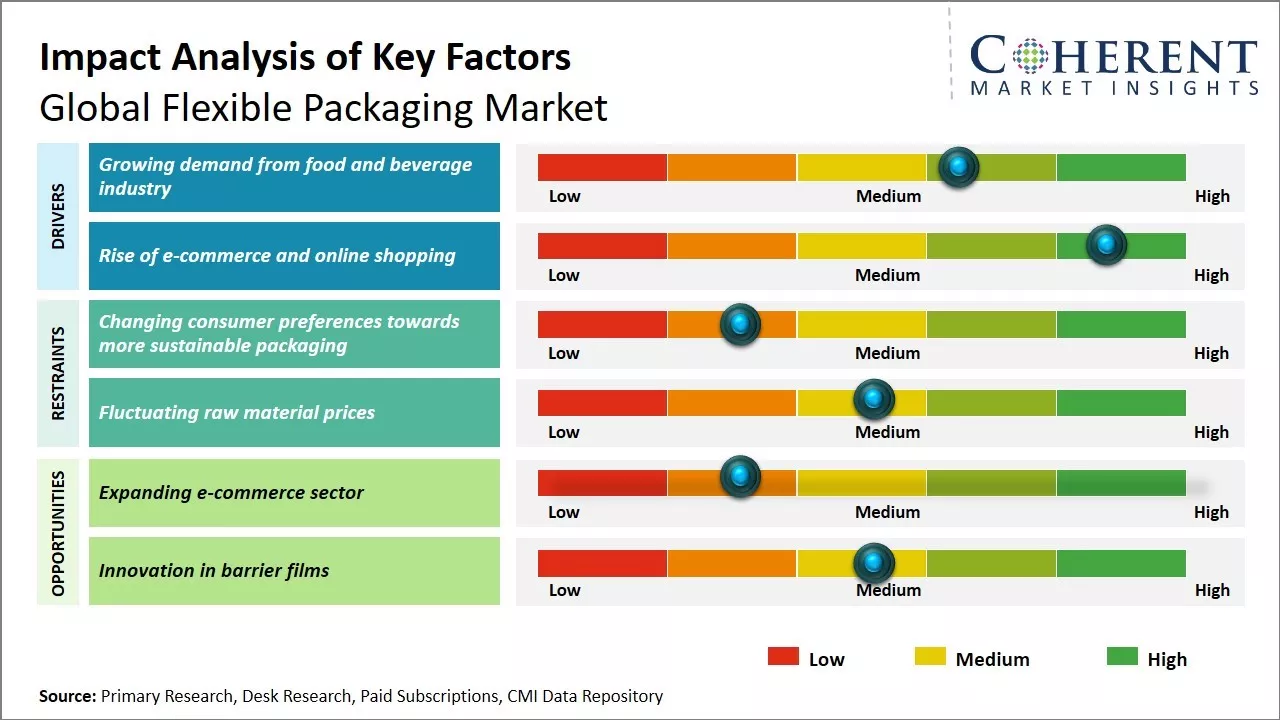
To learn more about this report, request a free sample copy
The increasing demand for flexible packaging from the food & beverage industry is the major factor driving the market growth. Flexible packaging provides advantages like durability, lightweight, and reusability. Moreover, flexible packaging produces less waste and uses fewer resources compared to rigid packaging. Rising environmental concerns are increasing the demand for flexible packaging as it is recyclable and produces less garbage. The growing e-commerce industry globally is another factor fueling the growth of the flexible packaging market. However, the availability of substitutes like molded fiber packaging and paper bags may hinder the market growth of flexible packaging.
Growing demand from the food and beverage industry
The food and beverage industry is increasingly adopting flexible packaging formats for their products. Flexible packaging is highly suitable for the food and beverage industry as it protects products from damage, provides longer shelf life, and enhances product appeal through colorful printing options. Flexible formats like stand-up pouches, shrink films, and wraps are lightweight, easy to transport, and use less material. They provide similar or better protection compared to rigid packaging formats. This makes flexible packaging an economical and sustainable solution for food manufacturers and retailers. Given the growing demand for packaged and ready-to-eat foods across regions, flexible packaging manufacturers are continuously innovating their product offerings to cater to the changing needs of food companies. Stand-up pouches are being introduced for various powdered mixes and snacks owing to their strong barrier properties and ability to stand independently on shelves. Retort packaging which can withstand high temperatures is gaining popularity for ready meals. Multilayer films are utilized for fresh meat, seafood, and bakery items to increase shelf life. Companies are also incorporating advanced digital printing on flexible films to replicate the designs of rigid jars and enhance the package appeal. Thus, evolving packaging needs as well as increased consumption of packaged foods and beverages is expected to drive significant demand for flexible packaging formats in the coming years. For instance, according to data published by Invest India in 2022, by 2025 the Indian food processing market is estimated to reach US$ 535 Bn, growing at a compound annual growth rate of 15.2%.
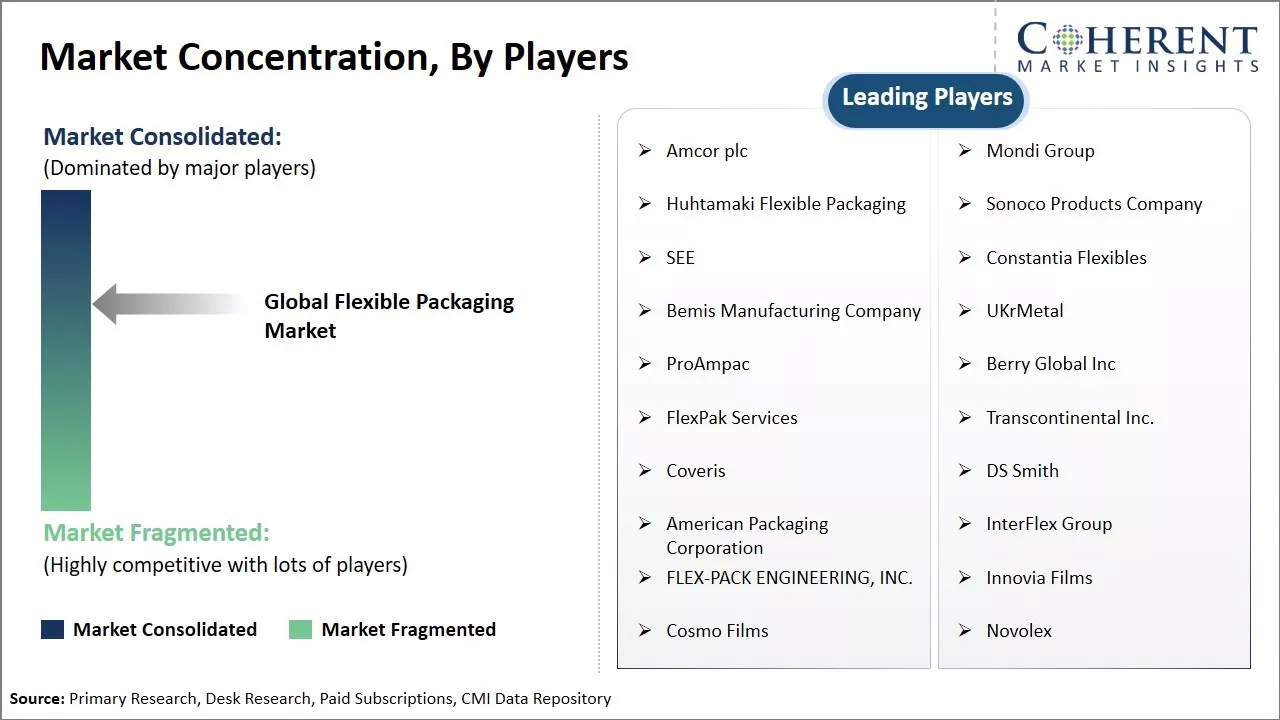
To learn more about this report, request a free sample copy
Rise of e-commerce and online shoppingThe proliferation of e-commerce and rise of online shopping platforms across the world has opened significant opportunities for the flexible packaging market. While rigid packaging remains suitable for durable goods, flexible packaging formats are highly preferable for shipping and delivering varied products through online channels. Flexible pouches, bags, and wraps provide effective protection to products during transportation while ensuring minimum shipping costs due to optimum space utilization and lightweight nature. Their sealing ability also prevents damage and product spillage compared to rigid containers. Flexible packaging manufacturers are thus developing formats and materials customized for secure delivery of apparel, cosmetics, stationery and other consumer goods via online shopping. Specialty mailing bags, vinyl woven bags, zipper pouches, and kraft paper wraps with reinforced edges are some innovations witnessed. Digital printing facilitated personalized designing of packaging according to merchant and delivery brand identity. Flexible packaging plays a pivotal role in enhancing the unboxing experience for online customers and building merchant credibility. Their sustainable credentials also align well with the green priorities of e-tailers and logistics companies.
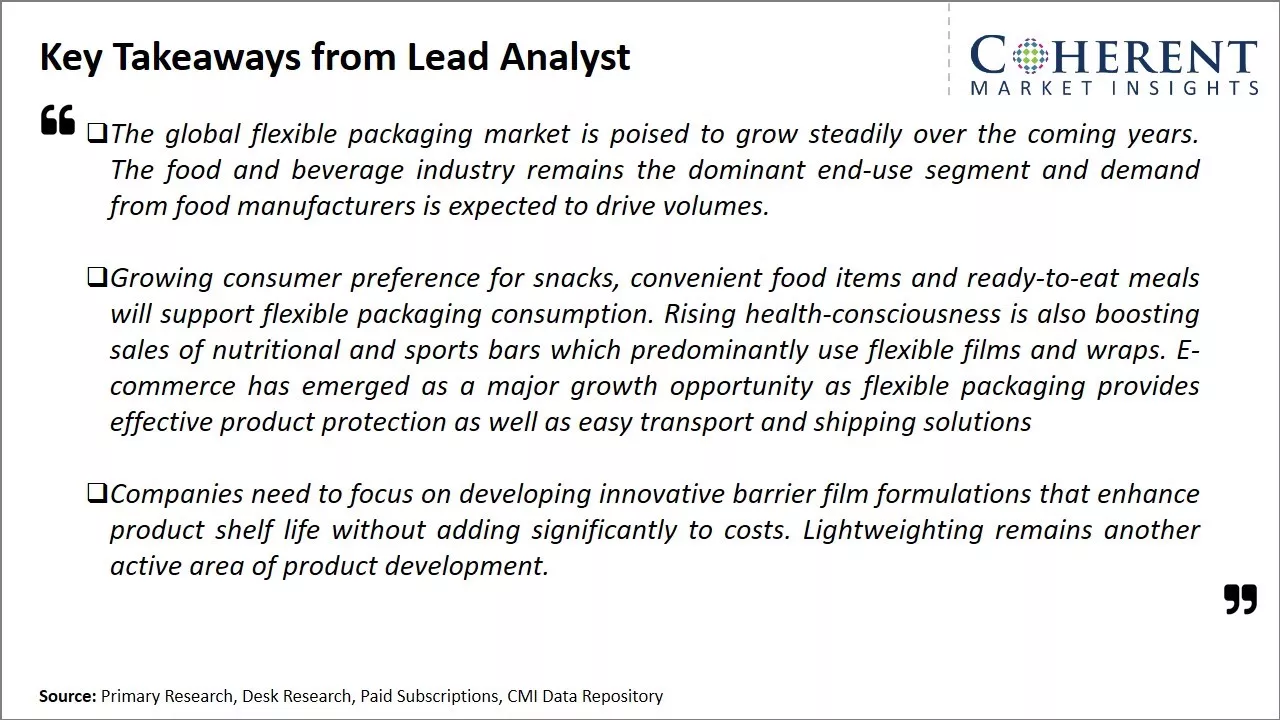
To learn more about this report, request a free sample copy
Challenges: Changing consumer preferences towards more sustainable packagingChanging consumer preferences towards more sustainable packaging options poses a threat as consumers are seeking packaging that uses less plastic. Stringent government regulations around the use of plastics also present a challenge. Additionally, intense competition in the market along with price volatility of raw materials like plastic resins puts pressure on flexible packaging manufacturers' margins.
Opportunities: Expanding e-commerce sector
The expanding e-commerce sector fuels the demand for effective packaging solutions for shipping products. Growth in industries like food and beverages, pharmaceuticals, and personal care drives the need for packaged goods. Flexible packaging offers advantages over rigid alternatives in terms of cost effectiveness and ability to extend product shelf life.
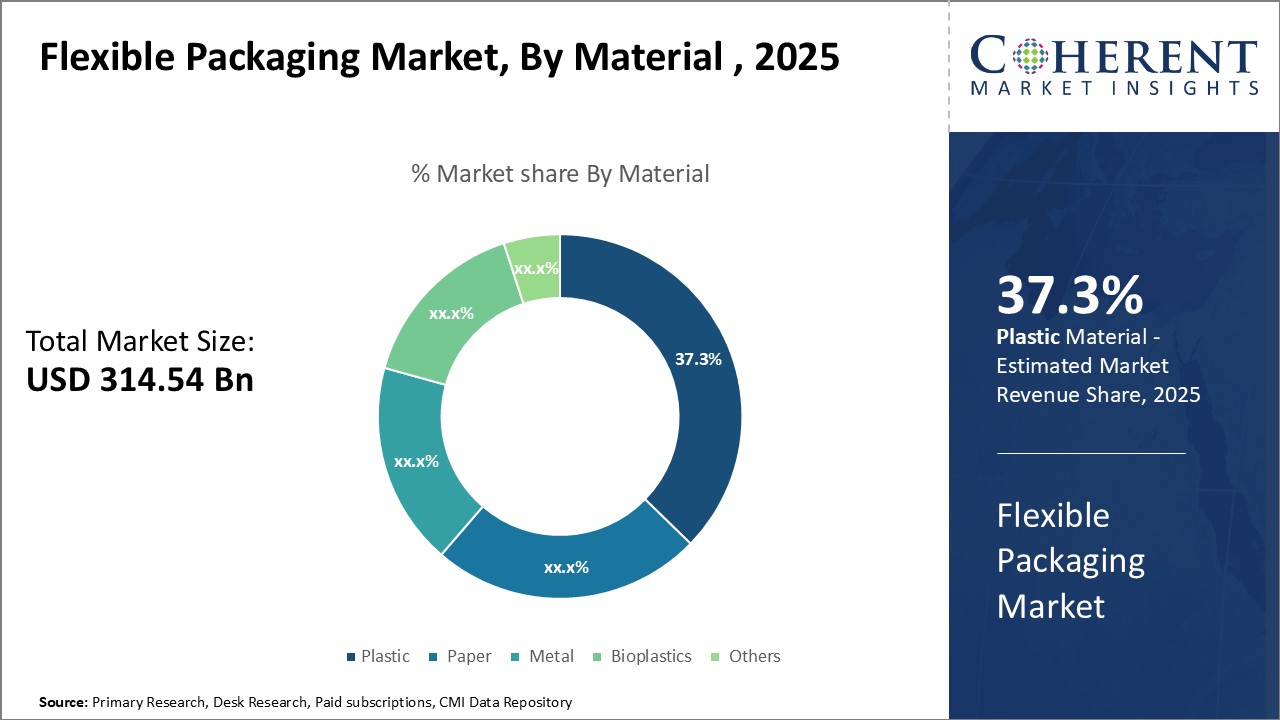
To learn more about this report, request a free sample copy
Insights, by Material: Affordability and Variety Drive Plastic's DominanceIn terms of material, plastic contributes 36.8% of the market share in 2024 of the market owning to its affordability and variety of applications. Being a versatile material, plastic can be easily molded into various forms and shapes. This allows flexible plastic packaging to protect a wide range of products across industries. From food and beverages to pharmaceuticals and personal care, plastic packaging fulfills the needs of numerous end uses effectively. The affordability of plastic makes it an attractive solution for both manufacturers and consumers. Compared to other materials like paper and metal, plastic has a lower raw material and production cost. This cost-efficiency enables companies to package their goods at reasonable prices without major impact on profit margins. Lower packaging costs are eventually passed on to consumers in the form of affordable prices. Affordability facilitates greater product accessibility, growing plastic's applicability. Plastic materials like polyethylene (PE), polypropylene (PP), and polyethylene terephthalate (PET) offer advantages like durability, printability, and moisture resistance. Their barrier properties protect the products from external factors like humidity and contamination. Plastic resins also give packaging designers creative freedom to develop custom container shapes, sizes, and graphics as per brand needs. This drives brand differentiation and marketing on shelves. The development of bio-plastic variants has further augmented plastic's versatility. Bio-plastics derived from renewable plant-based sources bring the same functionality with lower eco-footprint. Their biodegradability addresses sustainability concerns regarding plastic waste. Such innovations will aid plastic's continued dominance in the packaging spectrum.
Insights, by Product Type: Stand-up Pouches Lead as an Efficient Solution
In terms of product type, stand-up pouches contributes 31.3% of the market share in 2024. Stand-up pouches maximize space utilization due to their three-dimensional shape. More product can be packed in lesser space, improving load per truck or shipping container. This directly cuts transportation and logistics costs. Being self-standing, stand-up pouches do not require extra packaging material like boxes. Their peel-open feature provides easy access to contents without additional utensils like boxes. This enhances consumer convenience during use. Stand-up pouches are ideally suited for powders, liquids and snacks which are accessed regularly. From a manufacturing point of view, stand-up pouches require less raw material compared to rigid alternatives. Their use of laminated web rolls and form-fill-seal technology makes production highly automated with better speeds. This reduces per piece costs. Stand-up pouches are recyclable and optionally come with re-sealable zippers or pouring fits depending on product needs. Brands recognize the shelf-popping visibility provided by stand-up pouches due to their upright showcase format. Vibrant graphics and customer messaging can be leveraged for strong on-shelf appeal and impulse buying. Top brands across food, pet care, and other segments are switching to stand-up pouches for their competitive edge in busy retail aisles.
Insights, by Application: Food & Beverage Continues its Packaging Dominance
In terms of application, food & beverage contributes 36.5% share of the market in 2024 owing to extensive packaging needs. As lifestyles evolve with changing consumer demands, the packaging format preferences are also undergoing rapid change. Flexible pouches and bags fit the bill perfectly. From snacks to frozen meals and pet food, flexible packaging variations like stand-up pouches, spiral wound bags, and flow-wraps pack diversity. Their barrier properties protect contents across the fresh, frozen, and perishable categories. Beverage manufacturers leverage flexible packs for point-of-sale shipment and store displays. Pouches and aseptic bags enable the transport of liquids while occupying less space than glass or rigid containers. Shelf-stable formats keep products fresh. Customizable bag-in-box solutions benefit food service players. Flexible laminates and coextrusions meet regulatory standards for direct food contact. Rising health-consciousness is shifting diets towards portable packaged products with transparent labeling. Flexible pouches cater to this lifestyle need through functional attributes like re-closability, dip-spoon inserts, and dispensing nozzles. Their applications in nutraceuticals, vitamins, and meal replacement supplements also see strong growth. The growing frozen food segment looks up to flexible laminates barrier properties against moisture, oxygen, and light. This helps extend the shelf-life of ready-to-cook meals, vegetables, and snacks without refrigerator needed at point-of-sale or consumption. Given the diverse packaging demand, the food and beverage industry will continue powering the flexible packaging market.
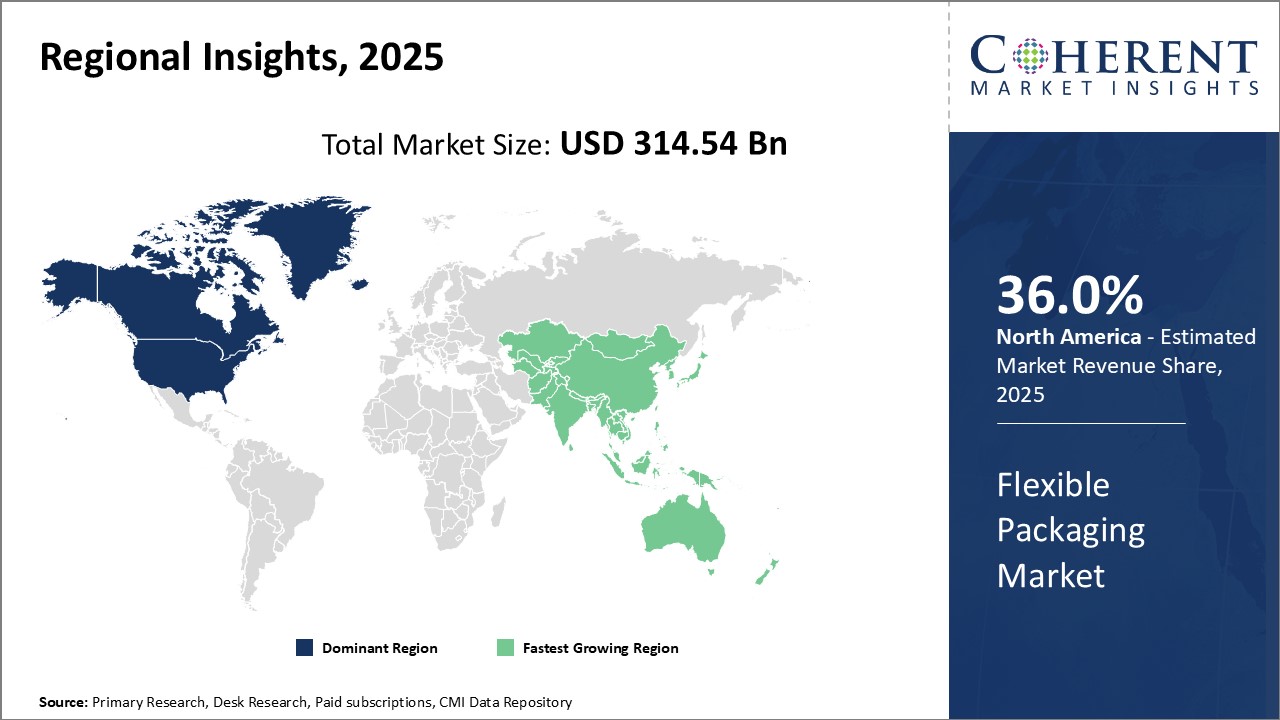
To learn more about this report, request a free sample copy
North America remains the leading region in the global flexible packaging market with 35.5% of the market share in 2024, driven by strong demand from various end-use industries such as food and beverages, pharmaceuticals, personal care, and cosmetics. The flexible packaging industry has a significant presence in the U.S. owing to well-established manufacturing facilities of major players and availability of cutting-edge technologies. Additionally, growing consumption of packaged and processed food have accelerated the uptake of flexible plastic films and pouches in the food industry. Moreover, the U.S. is a leading exporter of flexible packages to other countries due to stringent waste management regulations, which mandate the use of lightweight and recyclable packaging materials.
Asia Pacific has emerged as the fastest growing regional market for flexible packaging over the past few years. Rapid industrialization and rising disposable incomes have augmented the demand for packaged goods across nations such as India and China. The expanding middle-class population is inclined toward packaged foods and beverages, which has spurred flexible packaging consumption. Domestic manufacturers are continuously enhancing their production capabilities through the acquisition of new machinery and equipment. Local players are engaged in import substitution to establish a robust supply chain within the region. In addition, the growing import and export of goods within Asia Pacific and from other regions has augmented the demand for flexible packages used in industrial packaging. Emerging economies offer attractive growth opportunities to flexible packaging companies given their aggressive market expansion strategies.
Flexible Packaging Market Report Coverage
| Report Coverage | Details | ||
|---|---|---|---|
| Base Year: | 2023 | Market Size in 2024: | US$ 298.11 Bn |
| Historical Data for: | 2019 To 2023 | Forecast Period: | 2024 To 2031 |
| Forecast Period 2024 to 2031 CAGR: | 5.3% | 2031 Value Projection: | US$ 426.74 Bn |
| Geographies covered: |
|
||
| Segments covered: |
|
||
| Companies covered: |
Amcor plc, Mondi Group, Huhtamaki Flexible Packaging, Sonoco Products Company, SEE, Constantia Flexibles, Bemis Manufacturing Company, UKrMetal, ProAmpac, Berry Global Inc, FlexPak Services, Transcontinental Inc., Coveris, DS Smith, American Packaging Corporation, InterFlex Group, FLEX-PACK ENGINEERING, INC., Innovia Films, Cosmo Films, and Novolex |
||
| Growth Drivers: |
|
||
| Restraints & Challenges: |
|
||
*Definition: The global flexible packaging market refers to the market for flexible packaging materials that can bend or be folded. It includes packaging products made from paper, plastic films, aluminum foil, and other materials. Flexible packaging solutions offer lightweight and cost-effective packaging options for various consumer goods and industrial products across industries like food and beverages, pharmaceuticals, personal care, and cosmetics. The global flexible packaging market has seen significant growth over the years owing to the increasing demand for convenient and sustainable packaging formats.
Frequently Asked Questions
Joining thousands of companies around the world committed to making the Excellent Business Solutions.
View All Our Clients